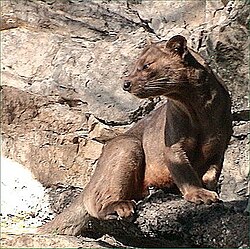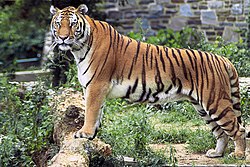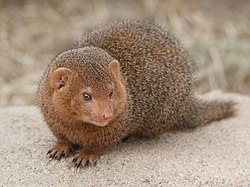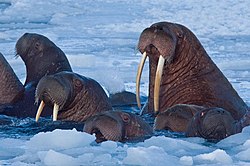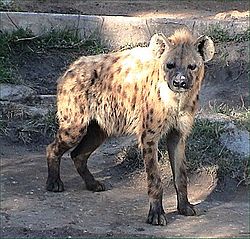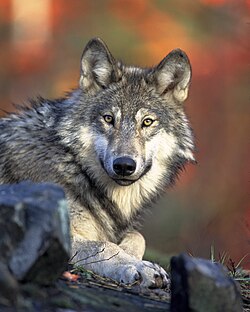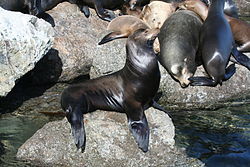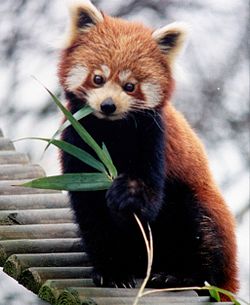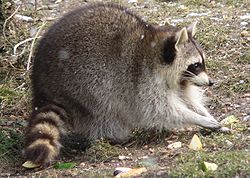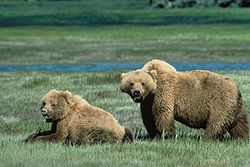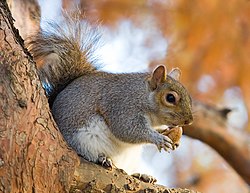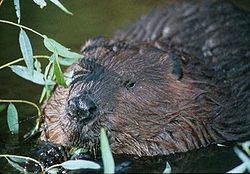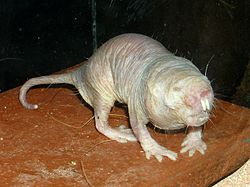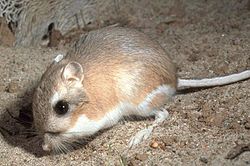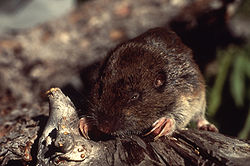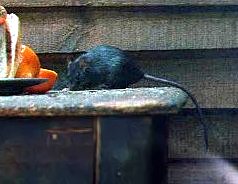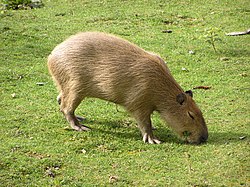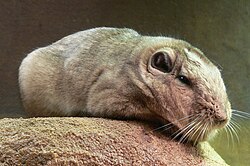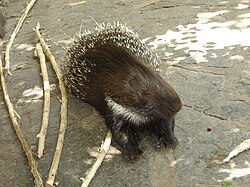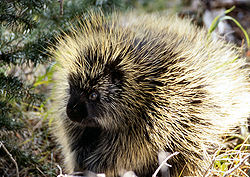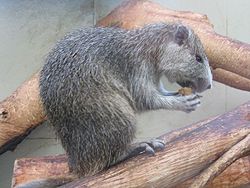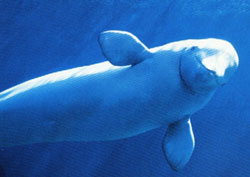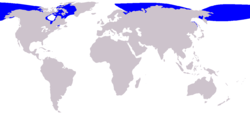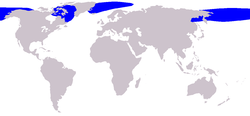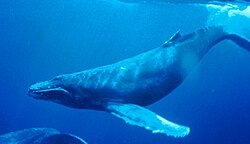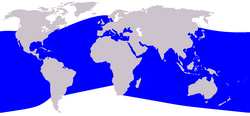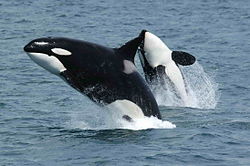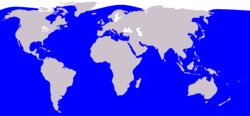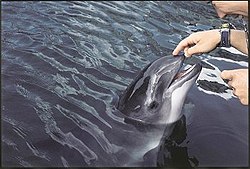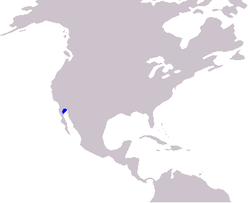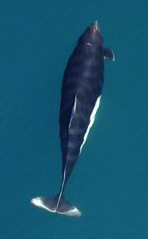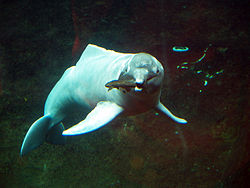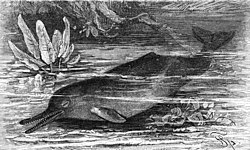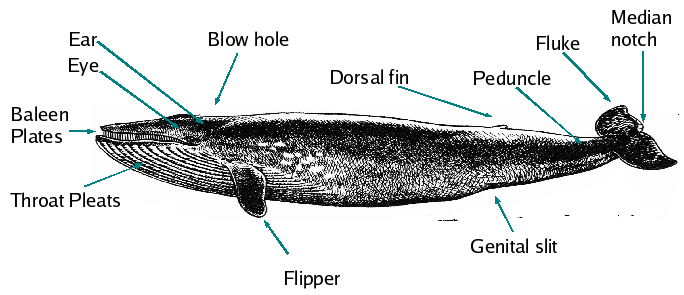Difference between revisions of "AY Honors/Mammals/Answer Key"
| (32 intermediate revisions by the same user not shown) | |||
| Line 8: | Line 8: | ||
:25 God made the wild animals according to their kinds, the livestock according to their kinds, and all the creatures that move along the ground according to their kinds. And God saw that it was good. | :25 God made the wild animals according to their kinds, the livestock according to their kinds, and all the creatures that move along the ground according to their kinds. And God saw that it was good. | ||
| − | :26 Then God said, "Let us make man in our image, in our likeness, and let them rule over the fish of the sea and the birds of the air, over the livestock, over all the earth, | + | :26 Then God said, "Let us make man in our image, in our likeness, and let them rule over the fish of the sea and the birds of the air, over the livestock, over all the earth, and over all the creatures that move along the ground." |
:27 So God created man in his own image, in the image of God he created him; male and female he created them. | :27 So God created man in his own image, in the image of God he created him; male and female he created them. | ||
| Line 33: | Line 33: | ||
==3. Give one or more identifying characteristics of each of the following orders of mammals, and name one or more species of mammals found in each order:== | ==3. Give one or more identifying characteristics of each of the following orders of mammals, and name one or more species of mammals found in each order:== | ||
| − | ===a. Marsupialia=== | + | ===a. Marsupialia=== |
| − | ===b. Insectivora=== | + | |
| − | ===c. Chiroptera=== | + | Marsupials have a pouch that protects the young as they are developing. The infant is born at very early stage of development and crawls out of the womb and across the mothers belly to the pouch where the baby finds a nipple that it attaches to as it continues to grow. |
| + | |||
| + | |||
| + | |||
| + | {| border ="0" | ||
| + | |- | ||
| + | | [[Image:Kangaroo and joey03.jpg|302px]]<br>'''Eastern Grey Kangaroo''' (Macropus giganteus) | ||
| + | | [[Image:Koala climbing tree.jpg|250px]]<br>'''Koala''' (Phascolarctos cinereus) <br>[[Image:AwesomePossum-AmericanOpossum.jpg|250px]]<br> '''Virginia Opossum''' (Didelphis virginiana) | ||
| + | |[[Image:Tasdevil large.jpg|250px]]<br>'''Tasmanian Devil''' (Sarcophilus harrisii)<br> [[Image:SpottedQuoll 2005 SeanMcClean.jpg|250px]] <br> '''Tiger Quoll''' (Dasyurus maculatus) | ||
| + | |- | ||
| + | |} | ||
| + | |||
| + | ===b. Insectivora=== | ||
| + | |||
| + | Insectivora means literally insect eater and that i the main connecting feature of the animals in this order. Many of the animals that were once a part of this order have been moved to other orders based on DNA analysis. The order Insectivora has ben replaced by the orders Erinaceomorpha and Soricomorpha. | ||
| + | |||
| + | {| border ="0" | ||
| + | |- | ||
| + | | [[Image:Igel.JPG|300px]] <br> '''European Hedgehog''' (Erinaceus europaeus) | ||
| + | | [[Image:Southern short-tailed shrew.jpg|300px]] <br> Southern Short-tailed Shrew (Blarina carolinensis) | ||
| + | | | ||
| + | |- | ||
| + | |} | ||
| + | |||
| + | ===c. Chiroptera=== | ||
| + | |||
| + | {| border ="0" | ||
| + | |- | ||
| + | | | ||
| + | | | ||
| + | | | ||
| + | |- | ||
| + | |} | ||
| + | |||
===d. Carnivora === | ===d. Carnivora === | ||
| − | ===e. Pinnipedia=== | + | |
| + | {| border ="0" | ||
| + | |- | ||
| + | |[[Image:Fossa.jpg|250px]]<br> fossa (Cryptoprocta ferox)<br> [[Image:Panthera_tigris_tigris_edited2.jpg|250px]] <br> Tigers (Panthera tigris)<br> [[Image:Dwarf_mongoose_Korkeasaari_zoo.jpg|250px]]<br>Dwarf Mongoose (Helogale parvula)<br> [[Image:Walrus.jpg|250px]] <br> Pacific Walrus | ||
| + | | [[Image:Spotted_hyena2.jpg|250px]] <br> Spotted Hyena, (Crocuta crocuta)<br>[[Image:Canis_lupus_laying.jpg|250px]] <br>Gray Wolf (Canis lupus) <br> [[Image:Sealion052006.JPG|250px]] <br> California Sea Lion, Zalophus californianus | ||
| + | | [[Image:Ailurus_fulgens_RoterPanda_LesserPanda.jpg|250px]]<br> Red Panda (Ailurus fulgens)<br> [[Image:Procyon_lotor_2.jpg|250px]] <br> Racoon (Procyon lotor) <br> [[Image:Grizzlybears_ChrisServheenUSFWS.jpg|250px]] <br> Grizzly Bear (Ursus horribilis) | ||
| + | |- | ||
| + | |} | ||
| + | |||
| + | |||
| + | ===e. Pinnipedia=== | ||
| + | |||
| + | This is no longer considered an order, it is now considered a superfamily of Carnivora | ||
| + | |||
===f. Rodentia=== | ===f. Rodentia=== | ||
| + | |||
| + | {| border ="0" | ||
| + | |- | ||
| + | | [[Image:Aplodontia.jpg|250px]]<br> Mountain Beaver (Aplodontia rufa) <br> [[Image:Eastern_Grey_Squirrel_in_St_James%27s_Park%2C_London_-_Nov_2006_edit.jpg|250px]] <br> Eastern Gray Squirrel (Sciurus carolinensis) <br> [[Image:Beaver.jpg|250px]] <br> American Beaver, (Castor canadensis) <br> [[Image:Nacktmull.jpg|250px]] <br> Naked Mole Rat (Heterocephalus glaber) | ||
| + | | [[Image:Kangaroo-rat.jpg|250px]] <br>Kangaroo rats <br> [[Image:Pocket_gopher.jpg|250px]] <br> Pocket Gopher <br> [[Image:Rattus_rattus05.jpg|250px]] <br> Black rat (Rattus rattus) <br> [[Image:Hydrochaeris_hydrochaeris.jpg|250px]] <br> capybara (Hydrochoerus hydrochaeris) | ||
| + | | [[Image:Gundi_Ctenodactylus_gundi_051117_2.jpg|250px]] <br> Gundi <br> [[Image:Brush_tailed_porcupine_Berlin_Zoo.jpg|250px]] <br> Old World Porcupine <br> [[Image:Porcupine_NPS11952.jpg|250px]] <br> North American Porcupine (Erethizon dorsatum) <br> [[Image:Capromys_pilorides.jpg|250px]] <br> Hutia (Capromys pilorides) | ||
| + | |- | ||
| + | |} | ||
| + | |||
===g. Lagomorpha=== | ===g. Lagomorpha=== | ||
| + | |||
| + | {| border ="0" | ||
| + | |- | ||
| + | | | ||
| + | | | ||
| + | | | ||
| + | |- | ||
| + | |} | ||
| + | |||
===h. Artiodactyla=== | ===h. Artiodactyla=== | ||
| − | ===i. Sirenia=== | + | |
| + | {| border ="0" | ||
| + | |- | ||
| + | | | ||
| + | | | ||
| + | | | ||
| + | |- | ||
| + | |} | ||
| + | |||
| + | ===i. Sirenia=== | ||
| + | |||
| + | {| border ="0" | ||
| + | |- | ||
| + | | | ||
| + | | | ||
| + | | | ||
| + | |- | ||
| + | |} | ||
| + | |||
===j. Cetacea=== | ===j. Cetacea=== | ||
| − | ==4. List four beneficial mammals and tell how they are beneficial.== | + | ==4. List four beneficial mammals and tell how they are beneficial.== |
| − | ==5. List four things mammals do that are harmful.== | + | ::Bats eat flying insects |
| − | ==6. List four mammals that are completely aquatic and designate their natural range.== | + | ::Dogs provide assistance to the blind and comfort to the sick. |
| − | ==7. Name the largest mammal in the world and tell where it lives, how it feeds, and what it eats.== | + | ::Cats keep down the rodent population |
| + | ::Hyena is a scavenger and helps keep the environment clean and free of disease | ||
| + | ::Any others that the Pathfinder can think of. Accept all reasonable answers. | ||
| + | |||
| + | ==5. List four things mammals do that are harmful.== | ||
| + | ::Skunks can make a neighborhood smell quite bad | ||
| + | ::Tigers, lions, bears, wolves and many other carniverous mammals have eaten people | ||
| + | ::Groundhogs, prairie dogs, gophers, moles and many other burrowing animals can create tripping hazards for humans, horses and other mammals | ||
| + | ::Elephants can do quite a bit of damage to gardens and yards | ||
| + | ::Mice can eat a large amount of grain and reproduce so rapidly that large quantities of food can disappear quite quickly. | ||
| + | ::Rats can carry disease such as bubonic plague | ||
| + | ::Dear can carry a desease known as cronic wasting disease | ||
| + | ::Beavers can back up streams and flood areas as well as cut down trees that are part of an orchard or yard | ||
| + | ::Many mammals can carry rabies or distemper and pass these diseses to humans or pets | ||
| + | ::Coyotes in urban setting can eat pets or spread garbage | ||
| + | ::Dear, moose and other large mammals kill many people by being hit by automobiles. | ||
| + | |||
| + | ==6. List four mammals that are completely aquatic and designate their natural range.== | ||
| + | :Salt Water Mammals | ||
| + | ::1. Whales | ||
| + | :::a. Blue Whale (''Balaenoptera musculus'') lives near the surface of the ocean and can be found in every ocean of the world. | ||
| + | ::::[[image:Faroe stamp 402 blue whale (Balaenoptera musculus).jpg|140px]] [[image:cetacea_range_map_Blue_Whale.PNG|240px]] | ||
| + | :::b. Beluga Whale (''Delphinapterus leucas'') lives in Arctic and Sub-Arctic waters. Some will migrate to warmer waters in the summer and even swim up northern rivers into brackish (partly-salty) waters to hunt. | ||
| + | ::::[[image:Belugawhale_MMC.jpg|240]] [[image:Cetacea range map Beluga.png|240px]] | ||
| + | :::c. Bowhead Whale (''Balaena mysticetu'') lives solely in the Arctic near the surface of the ocean. | ||
| + | ::::[[image:Bowheads42.jpg|240px]] [[image:Cetacea range map Bowhead Whale.png|240px]] | ||
| + | :::d. Humpback Whale (''Megaptera novaeangliae'') lives in all the oceans in the world except the polar seas. The live mostly in shallow water. | ||
| + | ::::[[image:Humpback_Whale_underwater_shot.jpg|240px]] [[image:Cetacea_range_map_Humpback_Whale.PNG|240px]] | ||
| + | ::2. Dolphins | ||
| + | :::a. Bottlenose Dolphins (''Tursiops truncatus'') live in warm and temperate seas and oceans all over the world. | ||
| + | ::::[[Image:Tursiops_truncatus_head.jpg|240px]] [[Image:Cetacea_range_map_Bottlenose_Dolphin.PNG|240px]] | ||
| + | :::b. Orcas or Killer Whales (''Orcinus orca'') live in all the oceans and many of the seas in the world. (Even though this aquatic mammal has the name of "whale" it is in the dolphin (''Delphinidae'') family) | ||
| + | ::::[[Image:Killerwhales_jumping.jpg|240px]] [[Image:Cetacea_range_map_Orca.PNG|240px]] | ||
| + | :::c. Spinner Dolphin (''Stenella longirostris''): | ||
| + | ::::1.Eastern Spinner Dolphin (''S. l. orientalis''), found in the tropical eastern Pacific. | ||
| + | ::::2.Central American or Costa Rican Spinner Dolphin (''S. l. centroamericana''), also found in the tropical eastern Pacific. | ||
| + | ::::3.Gray's or Hawaiian Spinner Dolphin (''S. l. longirostris''), found in the central Pacific around Hawaii but represents a mixed bag of broadly similar subtypes found throughout the world. | ||
| + | ::::4.Dwarf Spinner Dolphin (''S. l. roseiventris''), first found in the Gulf of Thailand. | ||
| + | ::::[[Image:SpinnerDolphinsoffKauai_1999-03-15.jpg|240px]] [[Image:Cetacea_range_map_Spinner_Dolphin.PNG|240px]] | ||
| + | :::d. Pacific White Sided Dolphin (''Lagenorhynchus obliquidens'') lives in the Pacific Ocean | ||
| + | ::3. Porpoise | ||
| + | :::a. Finless Porpoise (''Neophocaena phocaenoides'') lives in the shallow coastal waters of Asia especially around India, China, Indonesia and Japan. A unique fresh water population is found in the Yangtze River. At the western end, their range includes the length of the western coast of India and continues up into the Persian Gulf. | ||
| + | ::::[[Image:Neophocaena_phocaenoides.jpg|240px]] [[Image:Cetacea_range_map_Finless_Porpoise.PNG|240px]] | ||
| + | :::b. Harbour Porpoise (''Phocoena phocaena'') is widespread in cooler coastal waters in the Northern Hemisphere, largely in areas with a mean temperature of about 15°C. In the Atlantic, Harbour Porpoises may be present in a concave band of water running from the coast of western Africa round to the eastern seaboard of the United States, including the coasts of Spain, France, the United Kingdom, Ireland, Norway, Iceland, Greenland and Newfoundland. | ||
| + | ::::[[Image:Porpoise_touching.jpg|240px]] [[Image:Cetacea_range_map_Harbour_Porpoise.PNG|240px]] | ||
| + | :::c. Vaquita (''Phocoena sinus'') is a very endangered species that lives only in the Sea of Cortez, the northern part of the Gulf of California. | ||
| + | ::::[[Image:Cetacea_range_map_Vaquita.PNG|240px]] | ||
| + | :::d. Dall's Porpoise (''Phocoenoides dalli'') ranges across the north Pacific Ocean from southern California to southern Japan (including the Sea of Japan in the south up to the Bering Sea in the north). | ||
| + | ::::[[Image:Dalls_Porpoise_Back.jpg|240px]] [[Image:Cetacea_range_map_Dall%27s_Porpoise.PNG|240px]] | ||
| + | |||
| + | :Fresh Water Mammals | ||
| + | ::1. Amazon or Pink Dolphin (''Inia geoffrensis'') lives in the Amazon River and Orinoco River systems. | ||
| + | ::::[[Image:Inia.jpg|240px]] [[Image:Cetacea_range_map_Amazon_River_Dolphin.PNG|240px]] | ||
| + | ::2. Ganges and Indus River Dolphin or Indian River Dolphin (''Platanista gangetica'') lives in the Ganges River in India and in the Indus River in Pakistan. | ||
| + | [[Image:Schnabeldelphin-drawing.jpg|240px]] [[Image:Cetacea_range_map_Indus_and_Ganges_River_Dolphin_2.png|240px]] | ||
| + | |||
| + | ==7. Name the largest mammal in the world and tell where it lives, how it feeds, and what it eats.== | ||
| + | |||
| + | The Blue Whale (Balaenoptera musculus) is the largest animal on the planet. Specimens have been recorded over 30 meters in length and are estimated to weigh more than 90 tonnes. These whales have been seen in every ocean of the world and feed by filtering the water through the giant balleen plates in their mouth. Adult whales can eat up to 4 tonnes krill (euphausiids) and copepods each day and the calves can drink up to 400 litres/day. | ||
| + | |||
| + | ::[[Image:Baleen_parts.png]] | ||
| + | |||
| + | These amazing creatures were hunted by man to the brink of extinction. Over 378,000 were killed to provide oil and whale meat. The population is now only about 1% of the total 100 years ago. | ||
| + | |||
==8. List eight species of wild mammals that are in your region. Spend at least 5 hours searching for wild mammals in there natural habitat.== | ==8. List eight species of wild mammals that are in your region. Spend at least 5 hours searching for wild mammals in there natural habitat.== | ||
==9. Write or tell a story about "Wild Mammals I Have Observed".== | ==9. Write or tell a story about "Wild Mammals I Have Observed".== | ||
==References== | ==References== | ||
| + | http://en.wikipedia.org/wiki/Cetacea | ||
[[Category:Adventist Youth Honors Answer Book|{{SUBPAGENAME}}]] | [[Category:Adventist Youth Honors Answer Book|{{SUBPAGENAME}}]] | ||
Revision as of 23:18, 6 January 2007
1. What Bible verse gives the day mammals were created?
Genesis 1:24,25, 31
- 24 And God said, "Let the land produce living creatures according to their kinds: livestock, creatures that move along the ground, and wild animals, each according to its kind." And it was so.
- 25 God made the wild animals according to their kinds, the livestock according to their kinds, and all the creatures that move along the ground according to their kinds. And God saw that it was good.
- 26 Then God said, "Let us make man in our image, in our likeness, and let them rule over the fish of the sea and the birds of the air, over the livestock, over all the earth, and over all the creatures that move along the ground."
- 27 So God created man in his own image, in the image of God he created him; male and female he created them.
- 28 God blessed them and said to them, "Be fruitful and increase in number; fill the earth and subdue it. Rule over the fish of the sea and the birds of the air and over every living creature that moves on the ground."
- 29 Then God said, "I give you every seed-bearing plant on the face of the whole earth and every tree that has fruit with seed in it. They will be yours for food.
- 30 And to all the beasts of the earth and all the birds of the air and all the creatures that move on the ground—everything that has the breath of life in it—I give every green plant for food." And it was so.
- 31 God saw all that he had made, and it was very good. And there was evening, and there was morning—the sixth day.
2. List four characteristics of a mammal.
- 1. Endothermic (Warm-blooded)
- 2. Hair or Fur
- 3. Mammary (milk producing) glands
- 4. Sebaceous (fat-secreting) glands
- 5. Heterodont Dentition (Different shapes of teeth in their mouths)
3. Give one or more identifying characteristics of each of the following orders of mammals, and name one or more species of mammals found in each order:
a. Marsupialia
Marsupials have a pouch that protects the young as they are developing. The infant is born at very early stage of development and crawls out of the womb and across the mothers belly to the pouch where the baby finds a nipple that it attaches to as it continues to grow.
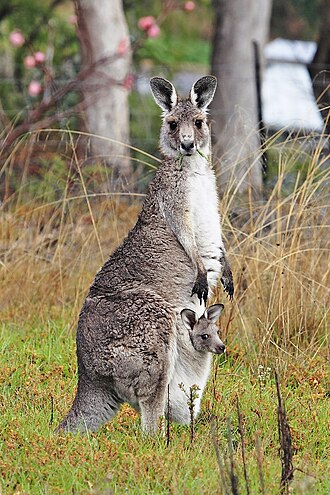 Eastern Grey Kangaroo (Macropus giganteus) |
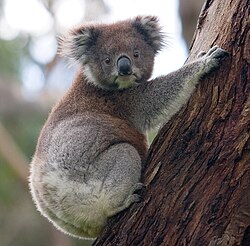 Koala (Phascolarctos cinereus) 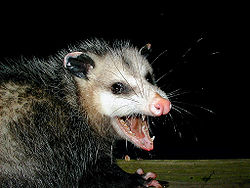 Virginia Opossum (Didelphis virginiana) |
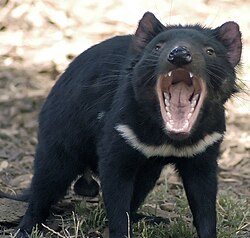 Tasmanian Devil (Sarcophilus harrisii) 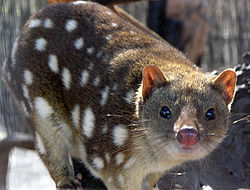 Tiger Quoll (Dasyurus maculatus) |
b. Insectivora
Insectivora means literally insect eater and that i the main connecting feature of the animals in this order. Many of the animals that were once a part of this order have been moved to other orders based on DNA analysis. The order Insectivora has ben replaced by the orders Erinaceomorpha and Soricomorpha.
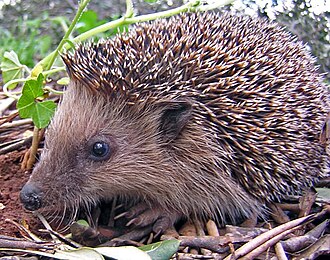 European Hedgehog (Erinaceus europaeus) |
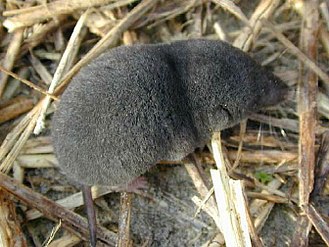 Southern Short-tailed Shrew (Blarina carolinensis) |
c. Chiroptera
d. Carnivora
e. Pinnipedia
This is no longer considered an order, it is now considered a superfamily of Carnivora
f. Rodentia
g. Lagomorpha
h. Artiodactyla
i. Sirenia
j. Cetacea
4. List four beneficial mammals and tell how they are beneficial.
- Bats eat flying insects
- Dogs provide assistance to the blind and comfort to the sick.
- Cats keep down the rodent population
- Hyena is a scavenger and helps keep the environment clean and free of disease
- Any others that the Pathfinder can think of. Accept all reasonable answers.
5. List four things mammals do that are harmful.
- Skunks can make a neighborhood smell quite bad
- Tigers, lions, bears, wolves and many other carniverous mammals have eaten people
- Groundhogs, prairie dogs, gophers, moles and many other burrowing animals can create tripping hazards for humans, horses and other mammals
- Elephants can do quite a bit of damage to gardens and yards
- Mice can eat a large amount of grain and reproduce so rapidly that large quantities of food can disappear quite quickly.
- Rats can carry disease such as bubonic plague
- Dear can carry a desease known as cronic wasting disease
- Beavers can back up streams and flood areas as well as cut down trees that are part of an orchard or yard
- Many mammals can carry rabies or distemper and pass these diseses to humans or pets
- Coyotes in urban setting can eat pets or spread garbage
- Dear, moose and other large mammals kill many people by being hit by automobiles.
6. List four mammals that are completely aquatic and designate their natural range.
- Salt Water Mammals
- 1. Whales
- a. Blue Whale (Balaenoptera musculus) lives near the surface of the ocean and can be found in every ocean of the world.
- b. Beluga Whale (Delphinapterus leucas) lives in Arctic and Sub-Arctic waters. Some will migrate to warmer waters in the summer and even swim up northern rivers into brackish (partly-salty) waters to hunt.
- c. Bowhead Whale (Balaena mysticetu) lives solely in the Arctic near the surface of the ocean.
- d. Humpback Whale (Megaptera novaeangliae) lives in all the oceans in the world except the polar seas. The live mostly in shallow water.
- 2. Dolphins
- a. Bottlenose Dolphins (Tursiops truncatus) live in warm and temperate seas and oceans all over the world.
- b. Orcas or Killer Whales (Orcinus orca) live in all the oceans and many of the seas in the world. (Even though this aquatic mammal has the name of "whale" it is in the dolphin (Delphinidae) family)
- c. Spinner Dolphin (Stenella longirostris):
- 1.Eastern Spinner Dolphin (S. l. orientalis), found in the tropical eastern Pacific.
- 2.Central American or Costa Rican Spinner Dolphin (S. l. centroamericana), also found in the tropical eastern Pacific.
- 3.Gray's or Hawaiian Spinner Dolphin (S. l. longirostris), found in the central Pacific around Hawaii but represents a mixed bag of broadly similar subtypes found throughout the world.
- 4.Dwarf Spinner Dolphin (S. l. roseiventris), first found in the Gulf of Thailand.
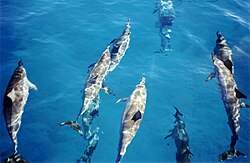
- d. Pacific White Sided Dolphin (Lagenorhynchus obliquidens) lives in the Pacific Ocean
- 3. Porpoise
- a. Finless Porpoise (Neophocaena phocaenoides) lives in the shallow coastal waters of Asia especially around India, China, Indonesia and Japan. A unique fresh water population is found in the Yangtze River. At the western end, their range includes the length of the western coast of India and continues up into the Persian Gulf.
- b. Harbour Porpoise (Phocoena phocaena) is widespread in cooler coastal waters in the Northern Hemisphere, largely in areas with a mean temperature of about 15°C. In the Atlantic, Harbour Porpoises may be present in a concave band of water running from the coast of western Africa round to the eastern seaboard of the United States, including the coasts of Spain, France, the United Kingdom, Ireland, Norway, Iceland, Greenland and Newfoundland.
- c. Vaquita (Phocoena sinus) is a very endangered species that lives only in the Sea of Cortez, the northern part of the Gulf of California.
- d. Dall's Porpoise (Phocoenoides dalli) ranges across the north Pacific Ocean from southern California to southern Japan (including the Sea of Japan in the south up to the Bering Sea in the north).
- 1. Whales
- Fresh Water Mammals
7. Name the largest mammal in the world and tell where it lives, how it feeds, and what it eats.
The Blue Whale (Balaenoptera musculus) is the largest animal on the planet. Specimens have been recorded over 30 meters in length and are estimated to weigh more than 90 tonnes. These whales have been seen in every ocean of the world and feed by filtering the water through the giant balleen plates in their mouth. Adult whales can eat up to 4 tonnes krill (euphausiids) and copepods each day and the calves can drink up to 400 litres/day.
These amazing creatures were hunted by man to the brink of extinction. Over 378,000 were killed to provide oil and whale meat. The population is now only about 1% of the total 100 years ago.
